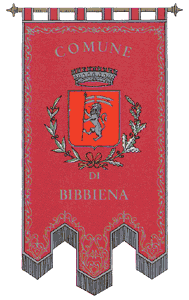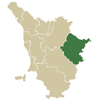|
 Inhabitants in 1991 : 10,969
Inhabitants in 1991 : 10,969
 The Municipal territory of Bibbiena extends over an area of 86,41
square kilometres of the Valdarno Casentinese, dominated by the ridge
of Pratomagno and of the Tosco-Romagnolo Apennine mountains. Antique possession
of the Bishops of Arezzo,
it became the capital of the municipality by a decree of 1776 when
twelve other hamlets were united with it, among which Moggiona and Prataglia,
subsequently passed to the municipality of Poppi.
The Municipal territory of Bibbiena extends over an area of 86,41
square kilometres of the Valdarno Casentinese, dominated by the ridge
of Pratomagno and of the Tosco-Romagnolo Apennine mountains. Antique possession
of the Bishops of Arezzo,
it became the capital of the municipality by a decree of 1776 when
twelve other hamlets were united with it, among which Moggiona and Prataglia,
subsequently passed to the municipality of Poppi.
Almost certainly of Estrucan origin, Bibbiena, since the X century
belonged to the Bishops of Arezzo.
In 1289, after the battle of Campaldino, it was conquered and devastated
by the Fiorentini ; in the XIV century it returned to the possession
of the Bishop of Arezzo
Guido Tarlati, and after his death passed to his brother Pier Saccone,
who yielded Arezzo to the Fiorentini in 1336 but retained the dominion
of Bibbiena. It was the centre of hostile action against Firenze it was
besieged and conquered by the Fiorentini in 1360, who made it the Podesta
office (the Fiorentino story teller Franco Sacchetti lived there as Podesta
in 1377). In 1440 it was occupied by the mercenaries of Niccolò
Piccinino in the service of Filippo Maria Visconti, Duke of Milano
and in 1498, it became the general quarters of Piero and Giuliano dei
Medici, who had been expelled from Firenze, it was besieged and devastated
again by the Fiorentini, who eleven years later, in 1509, pulled down
the walls and the towers. At the return of the Medicea dynasty however,
Bibbiena enjoyed many privileges conceded by Leone X. Bibbiena
saw the birth of Cardinale Bernardo Dovizi, capable diplomat to the Pontifical
Court of Leone X, protector of the most celebrated intellects of his time
(among these Raffaello) and author, among other things, of the Boccaccio
style comedy Calandria. During the second world war the population
of the municipality suffered grave reprisals : in the village
of Partina, which was invaded by the Nazis in April 1944, a great number
of inhabitants were massacred.
Places to Visit:
Palazzo Comunale, 1500s palace near which ran the perimeter
of the walls.
S.Lorenzo, Church of 1474 with three naves enriched by prestigious
works of art among which a terracotta glass panel from the studio
of Della Robbia.
Ippolito, Provost founded in at the start of the XII century,
already the chapel of the Tarlati Castle it was remodelled several
times, and finally taken back to the style of the1300-1400s. The Latin
cross interior, embellished with frescos, conserves valuable works
of art |
Historical info reproduced upon authorization of Regione Toscana - Dipartimento della Presidenza E Affari Legislativi e Giuridici
Translated by Ann Mountford
|